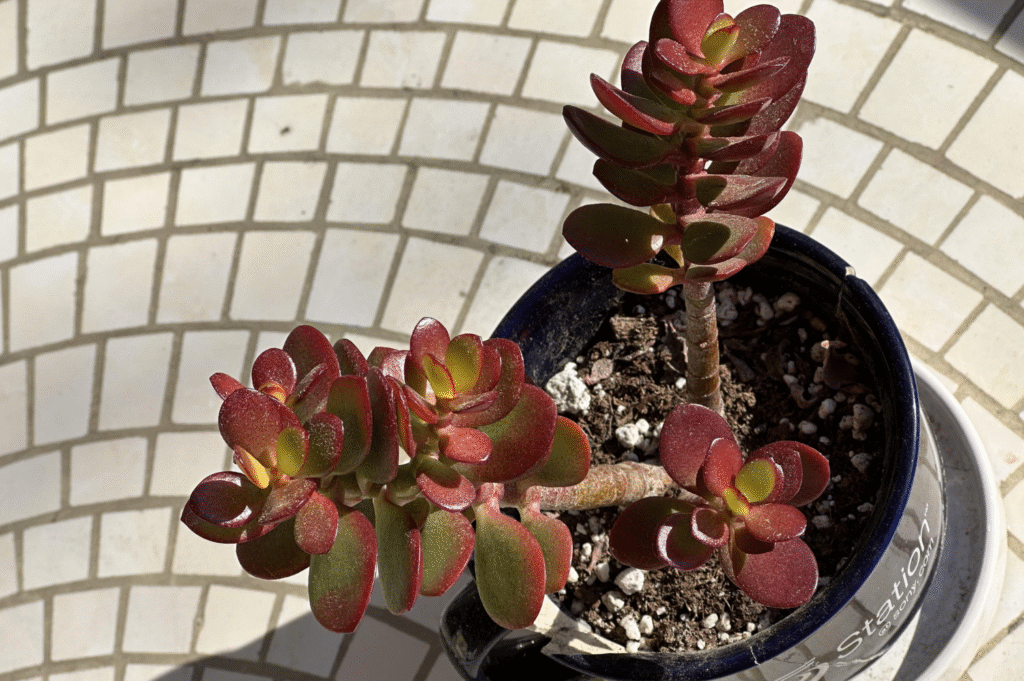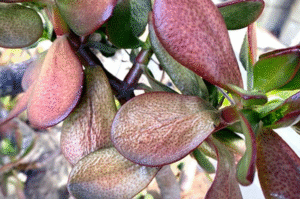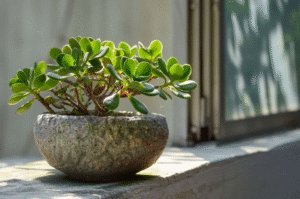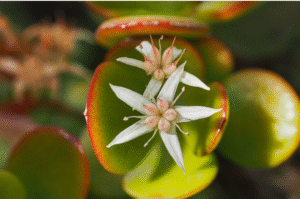Jade plants (Crassula ovata) are popular succulents known for their thick, fleshy green leaves and minimal care needs. However, if you’ve noticed your jade plant turning red, you’re not alone. While it may seem alarming at first, red leaves often indicate specific environmental responses or care issues. This article will help you understand why your jade plant is turning red, whether it’s normal or a problem, and how to fix or embrace it.
Is Red Coloring in Jade Plants a Problem?
In most cases, red-tinted leaves are not a sign of disease. Instead, they’re usually a natural response to stressors like strong light, temperature changes, or nutrient deficiencies. Sometimes, this color change can even make your plant more attractive and unique.
However, if the red color is accompanied by leaf drop, wilting, or soft stems, it could be a sign that your jade plant needs help.
Common Reasons Why Your Jade Plant Turns Red
Let’s explore the most common causes of red leaves in jade plants and what each means:
1. Exposure to Direct Sunlight
Cause:
Jade plants love bright light, but if you suddenly move them from low light to full sun, they can develop a red hue. This is the plant’s way of protecting itself from sunburn.
Fix:
Gradually introduce your jade plant to direct sunlight. If it’s outdoors, use partial shade or filter the light during peak sun hours (10 AM to 4 PM). Indoors, place it near an east- or west-facing window with indirect light.
Pro Tip: A slight red tint in the edges of the leaves often means your jade plant is thriving in bright light, not suffering.
2. Cold Temperatures or Sudden Temperature Fluctuations
Cause:
Jade plants are sensitive to cold. Temperatures below 50°F (10°C) can cause leaf stress, leading to reddish or purplish tones.
Fix:
Keep your jade plant in a warm spot, ideally between 65°F to 75°F (18°C to 24°C). Avoid drafty windows or areas near air conditioners in winter.
Expert Advice: Always bring jade plants indoors before the first frost if they’re kept outside.
3. Underwatering or Dehydration
Cause:
Jade plants store water in their leaves. If they don’t get enough, they may show signs of stress, including red or wrinkled leaves.
Fix:
Water thoroughly when the top 1–2 inches of soil feel dry. Make sure your pot has drainage holes to avoid root rot.
Caution: Overcorrecting underwatering by soaking the plant can lead to root problems. Rehydrate gradually.
4. Overfertilizing or Lack of Nutrients
Cause:
A build-up of fertilizer salts can damage roots, causing leaf discoloration. Conversely, nutrient deficiency (especially phosphorus or magnesium) might lead to red-tinted leaves.
Fix:
Use a balanced, diluted succulent fertilizer once every 4–6 weeks during the growing season (spring and summer). Flush the soil with water every few months to remove salt buildup.
Pro Tip: Avoid feeding your jade plant during fall and winter. This is its dormant period.
5. Natural Aging Process
Cause:
As jade plants mature, some leaves (especially older ones) naturally turn reddish or bronze before falling off. This is part of the plant’s growth cycle.
Fix:
No action is needed. Simply remove the dried or discolored leaves to keep the plant looking tidy.
6. High-Stress Environments (Intentional Stress Coloring)
Cause:
Some plant enthusiasts intentionally expose their jade plants to high light or slightly dry conditions to enhance red or orange coloring on the leaf edges. This is known as “color stress.”
Fix:
If your jade is healthy and showing beautiful red edges, enjoy the color. It’s often a sign of a well-lit and slightly toughened plant.
Caution: Don’t push stress too far. Excessive sun or lack of water can cross the line from colorful to harmful.
When to Worry About Red Leaves
Here are signs that red leaves may indicate a serious issue:
- Soft, mushy, or blackened leaves (possible rot)
- Leaves are dropping in large numbers
- Stunted growth or wrinkled stems
- Sticky residue or pests like mealybugs or scale
If you notice any of these signs, your plant may be dealing with overwatering, root rot, or pest infestation.
Quick Troubleshooting Table
| Symptom | Likely Cause | Solution |
| Red edges only | Sun stress (not harmful) | Provide indirect or filtered sunlight |
| Entire leaves are turning red | Cold exposure or dehydration | Move indoors, adjust watering routine |
| Red, wrinkled, and soft leaves | Severe underwatering | Water slowly and consistently |
| Red + white fuzz or sticky spots | Pests (mealybugs, scale) | Use neem oil or insecticidal soap |
| Red + leaf drop + mushy stems | Overwatering/root rot | Repot with dry soil, prune soft stems |
How to Keep Your Jade Plant Green and Healthy
If red leaves bother you and you want your plant to stay vibrant green, follow these core care tips:
- Light: Bright, indirect sunlight for at least 4-6 hours a day.
- Water: When the soil is dry to the touch, water it on a schedule.
- Soil: Well-draining cactus or succulent mix.
- Pot: Terracotta with drainage holes to prevent overwatering.
- Fertilizer: Monthly during the growing season, diluted to half strength.
Final Thoughts:
A red jade plant isn’t always a bad thing. It can be quite striking. But if the color comes with other symptoms, it may be a call for care.
Whether you want to embrace the red as a sign of a sun-kissed succulent or work toward bringing back that lush green look, understanding your jade’s needs is key. Always observe your plant closely and make small, gentle changes (never sudden ones).






